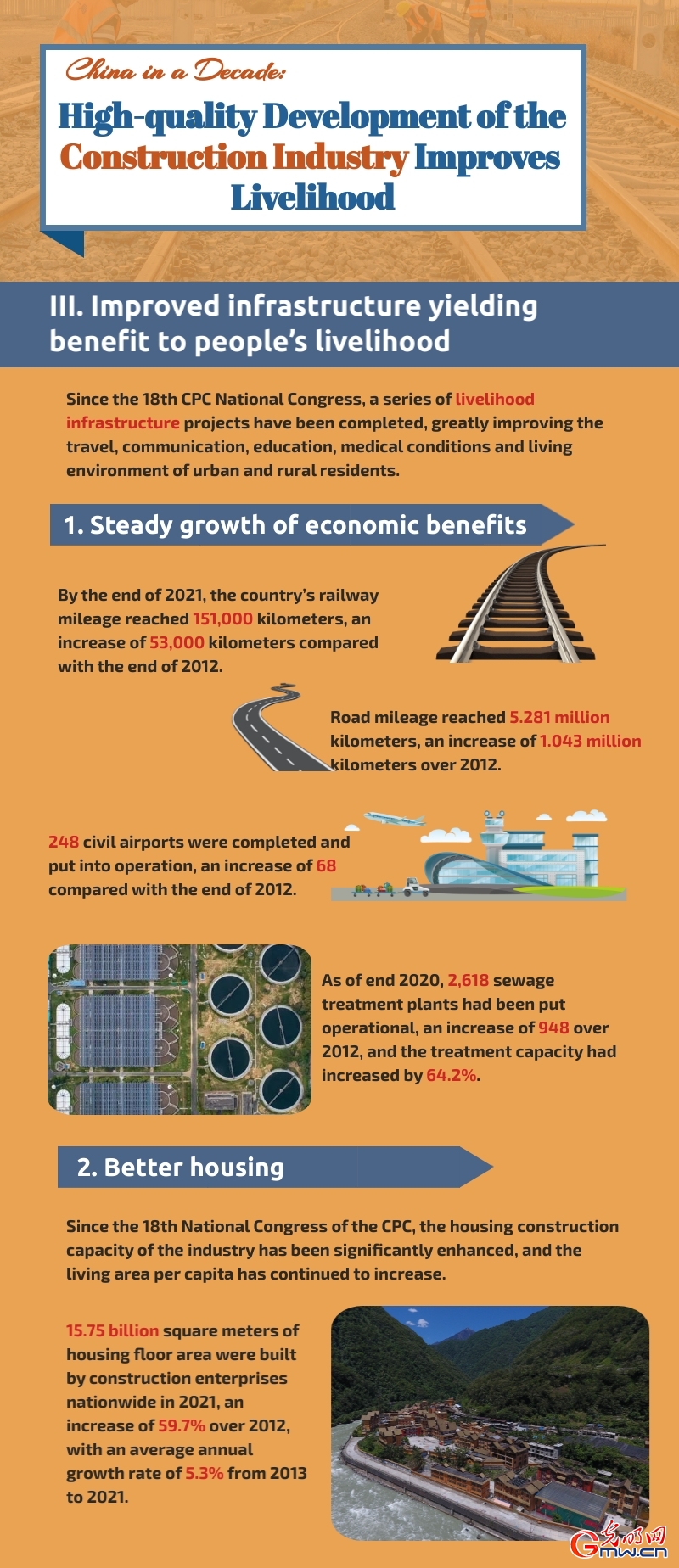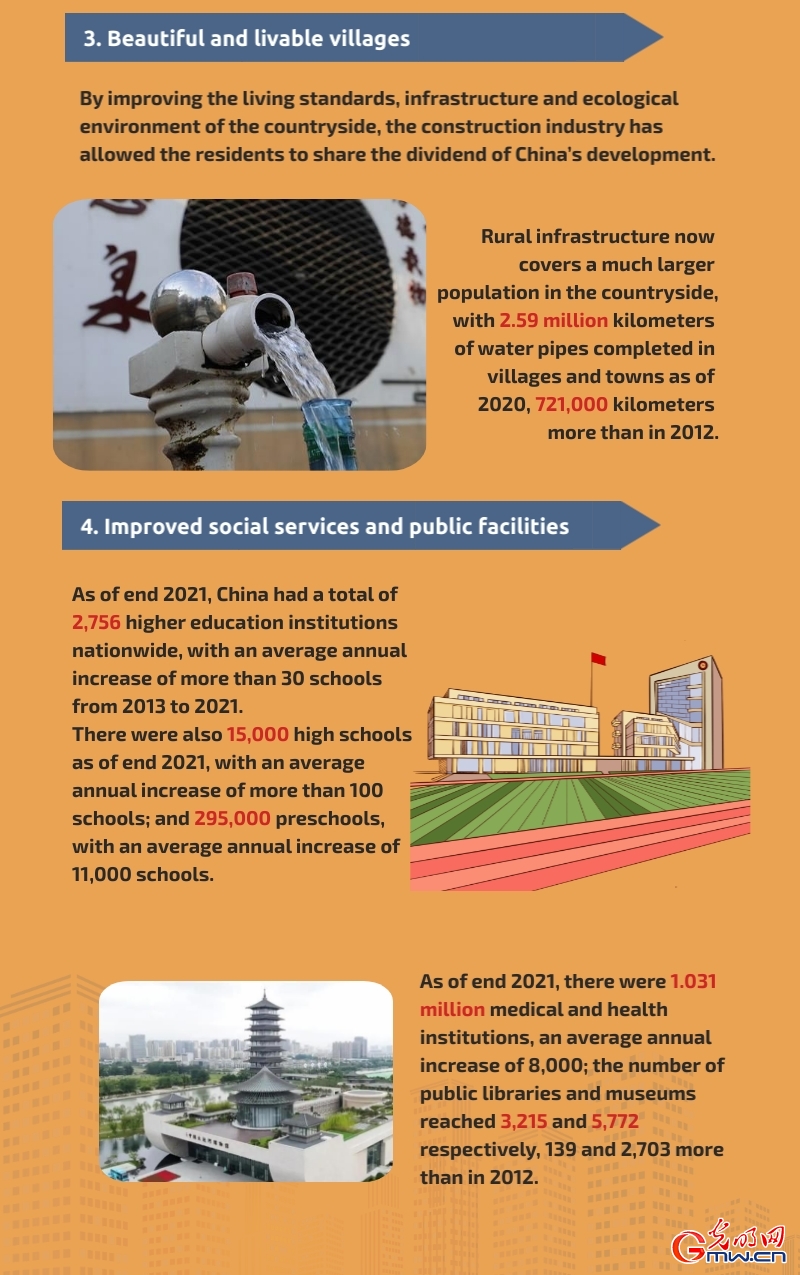


III. Improved infrastructure yielding benefit to people’s livelihood
Since the 18th CPC National Congress, a series of livelihood infrastructure projects have been completed, greatly improving the travel, communication, education, medical conditions and living environment of urban and rural residents.
1. Better infrastructure
By the end of 2021, the country’s railway mileage reached 151,000 kilometers, an increase of 53,000 kilometers compared with the end of 2012; road mileage reached 5.281 million kilometers, an increase of 1.043 million kilometers over 2012; and 248 civil airports were completed and put into operation, an increase of 68 compared with the end of 2012.
A total of 1.007 million kilometers of urban water pipelines had been completed as of the end of 2020, an increase of 415,000 kilometers compared to the end of 2012.
851,000 km of natural gas pipelines were completed, an increase of 508,000 km; 803,000 km of drainage pipelines were deployed, an increase of 364,000 km.
As of end 2020, 2,618 sewage treatment plants had been put operational, an increase of 948 over 2012, and the treatment capacity had increased by 64.2%.
IT infrastructure has been widely promoted across the country, with 54.881 million kilometers of fiber-optic cable deployed nationwide as of 2021, an increase of 2.71 times over 2012; and 9.96 million mobile phone base stations were constructed, including 1.425 million 5G base stations as of 2021, and 5G networks have covered all cities and counties above the prefecture level.
2. Better housing
Since the 18th National Congress of the CPC, the housing construction capacity of the industry has been significantly enhanced, and the living area per capita has continued to increase. 15.75 billion square meters of housing floor area were built by construction enterprises nationwide in 2021, an increase of 59.7% over 2012, with an average annual growth rate of 5.3% from 2013 to 2021.
The housing floor area per urban resident increased from 32.9 square meters in 2012 to 41.0 square meters in 2021.
The renovation of shantytowns, urban villages and dilapidated houses has been steadily implemented, and urban renewal has been promoted in an orderly manner, too. From 2015-2021, more than 31 million units of various types of shantytowns were renovated nationwide, benefiting about 60 million residents. From 2019-2021, a total of 115,000 old urban districts were renovated, benefiting more than 20 million households.

3. Beautiful and livable villages
By improving the living standards, infrastructure and ecological environment of the countryside, the construction industry has allowed the residents to share the dividend of China’s development.
Rural infrastructure now covers a much larger population in the countryside, with 2.59 million kilometers of water pipes completed in villages and towns as of 2020, 721,000 kilometers more than in 2012.
The treatment of rural domestic waste and sewage has been strengthened, with 222,000 kilometers of drainage pipes deployed as of 2020 at township and village levels, 75,000 kilometers more than in 2012.
At the same time, new progress has been made in information infrastructure in rural areas, with over 99% of villages connected to optical fiber and 4G network. All villages are now connected to broadband network, the Internet penetration rate at household level in rural areas has reached 57.6%.
4.Improved social services and public facilities
As of end 2021, China had a total of 2,756 higher education institutions nationwide, with an average annual increase of more than 30 schools from 2013 to 2021. There were also 15,000 high schools as of end 2021, with an average annual increase of more than 100 schools; and 295,000 preschools, with an average annual increase of 11,000 schools.
As of end 2021, there were 1.031 million medical and health institutions, an average annual increase of 8,000; the number of public libraries and museums reached 3,215 and 5,772 respectively, 139 and 2,703 more than in 2012.
(Source: National Bureau of Statistics)
点击右上角![]() 微信好友
微信好友
 朋友圈
朋友圈

请使用浏览器分享功能进行分享
